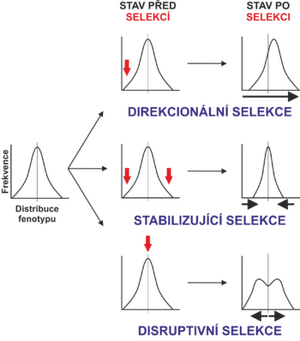Selection and its types
The term selection (= selection) in population genetics characterizes a situation that does not meet the limiting conditions for deriving the basic model (i.e. the average fertility of individuals is the same, independent of their genotype , so there is no selection).
- It is among the classical evolutionary mechanisms of Darwinism; there is always a reduction in the number of offspring .
- To measure the intensity of selection, we use the average number of offspring from a parent of a certain genotype; relative number is used, not absolute, where this relative value can be based on a ratio, for example, to the average number of offspring of all phenotypes or on a ratio to the number of offspring of the most fertile phenotype .
- From this we can derive: (i = max) i.e. the average number of offspring of genotype i / the average number of offspring of the most fertile genotype, where wi = absolute average number of offspring of genotype it:
- Relative reproductive capacity (also adaptive value) of a given genotype = .
- Election coefficient , which characterizes the intensity of selection: .
Selection against homozygotes[edit | edit source]
The starting population is in Castle–Hardy–Weinberg equilibrium .
When selection of intensity s i against recessive homozygotes aa (i = aa) begins, it will:
- frequency before selection : for (for , for , ); (pro , pro , );
- selection intensity : pro aa = s (pro AA = 0, pro Aa = 0);
- relative reproductive capacity : pro aa = 1 − s (pro AA = 1, pro Aa = 1);
- freequency after selection (pro , pro , ).
We calculate the gene frequency in the generation after selection as: q´ = .
- The size of the change is characterized by the selection difference (difference): Δq = q´ − q = .
- ∆q allows us to find out whether the investigated polymorphism is stable or transient, or how fast selection-induced changes take place.
In the case of stable polymorphism , ∆q = 0; this happens when the numerator of the fraction in the equation is 0, which can happen when:
- p = 0, i.e. the population consists only of homozygotes aa;
- (q = 0), the population consists only of AA homozygotes;
- s = 0, the considered selection does not occur;
- These three conditions = the so-called trivial (general, basic) conditions.
- Under non-trivial conditions, gene frequencies change (allele a decreases).
- The magnitude of this decline is directly proportional to the intensity of selection and the square of the gene frequency.
- If the gene frequency is high at the beginning, its decrease is greater.
- At smaller values of q, the decline slows down (biologically explainable by the fact that at low values of q, most a alleles in the genotype are heterozygotes, against which the given type of selection does not act).
- The dynamics of these gene frequency changes for the values of the selection coefficient have a sinusoidal character in various ways in the graph (dependency on time measured in generations).
Selection against both types of homozygotes[edit | edit source]
The so-called heterozygote preference (also referred to as super dominance or heterosis) ( and i ) leads to an equilibrium state where . ( a i ) .
Thus, equilibrium values of paq depend only on selection coefficients, not on allele frequencies.
- E.g. hemoglobinopathies in the homozygous constitution cause anaemia .
- A selection factor that affects dominant homozygotes is malaria infection , to which heterozygotes are partially resistant.
- An extreme case is a balanced lethal system , where and the population then consists only of heterozygotes (e.g. the T locus in the mouse, which is involved in the development caudal part of the body) a
- Some dominant (T) and recessive (t) alleles have a lethal effect in the homozygous constitution , usually due to severe disturbances during ontogeny ; whereas the mechanism of damage is different for dominant and recessive homozygotes, heterozygous individuals are viable.
Selection against heterozygotes[edit | edit source]
- E.g. fetal erythroblastosis .
- Except for the situation where p = q = 0.5, equilibrium can only be reached under trivial conditions.
- Since the non-trivial equilibrium p = q = 0.5 is easily violated, practically always under this type of selection there is a situation where the gene frequency of the allele with a higher frequency increases.
- Types of selection
1. Normalizing selection
- is applied in maintaining the current state of the population by excluding deviations from the norm; eg hereditary diseases.
2. Balancing selection
- maintains a certain degree of polymorphism in the population; e.g. heterozygote preference ( sickle cell disease ).
3. Directional selection
- is applied especially when the external conditions change, its action selects the best adapted phenotype.
- This is a typical effect of natural selection in the sense of classical Darwinism.
- E.g. industrial melanism of some insects.
Fisher's fundamental theorem of natural selection is: "The rate of rise in (relative) fertility of any organism at any time is equal to the genetic variance of (relative) fertility at that time". Better: "The greater the genetic variability that can be acted upon by selection toward higher fitness, the greater the progress in fitness." or "The rate of change of a trait depends exclusively on the additive genetic variance in the fitness of that trait." (1930)
Links[edit | edit source]
Related articles[edit | edit source]
Source[edit | edit source]
- STEFÁNEK, Jiří. Medicine, diseases, studies at the 1st Faculty of Medicine, UK [online]. [feeling. 2/11/2010]. < https://www.stefajir.cz/ >.





















